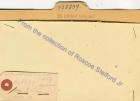|
SUSPENSION & STEERING: Torsion-Level - A Primer
|
||||
|---|---|---|---|---|
|
Forum Ambassador

|
Packard's revolutionary Torsion-Level Suspension, used on 1955-1956 models, is quite unlike any other torsion bar suspension system that came before or since.
Actually, this interconnected torsion bar suspension was the brainchild of William D. Allison, who worked for Hudson, back in the 1940s. When Hudson decided to forego further development, they allowed him to shop the idea around, independently. Ultimately, Packard licensed Allison's patent in 1951, with orders to proceed for development coming in 1952, and after extensive testing on several experimental cars in 1954, a green light for 1955 production. Two main (long) bars run along each side of the frame, connecting the front wheel to the rear (on the same side), which cause the suspension to pivot, fore-to-aft, about a virtual center. Because this system of two bars, alone, would settle-out based on weight distribution, a supplemental leveling system was added, which uses a level sensor and a single motor to load/unload a pair of auxiliary (short) bars to adjust the attitude (but NOT the overall riding height) of the car. Sales brochures, like The NEW Packard with fabulous Torsion-Level Ride explained the basic operation and extolled the benefits of this system for the prospective customer. Yet, there seems to be a lot of confusion among contemporary collectors as to the availability of Torsion-Level equipment on the 1955-1956 cars. I'd once read, long ago, that it was a "mandatory" option of sorts. Later, factory Trade Letters turned up that would show T-L as standard on the Caribbean and optional on some other models, but it was initially not offered on the 1955 Clipper Super until about mid-year and not available at all on the 1955 Clipper Deluxe. In May of 1956, Torsion-Level became standard equipment on all models. Previously, that year, it had been standard on Caribbean models and optional on all others, but with 100% installation on all models EXCEPT Clipper Deluxe and Clipper Super. However, a delete option was provided for the Deluxe, for production with conventional spring suspension. Curiously, the parts book only shows details of conventional spring suspension for the 56th Series as only applicable to the Deluxe (body 5622). This suggests that T-L may have been, in actual practice, 100% install on the 1956 Super line for the entire run. Perhaps there is some other factory document out there, somewhere, that will someday turn up and help clarify this. Advanced service information on this revolutionary suspension was released in the 1955 Serviceman's Training Book, The 55th Series Clipper-Packard Mechanical Changes and Torsion-Level Suspension, with about a third of its pages devoted to the T-L system. An in-depth treatise on the engineering behind the system was later published in an SAE paper, The New Packard Torsion Level Suspension by Forest McFarland, Chief Engineer of S-P's Advanced Engineering. Since the system is an electro-mechanical one, the full details of service and overhaul are covered between Section VIII - Electrical and Section XVI - Suspension & Steering of the 1955-1956 Packard Service Manual. (NOTE: The links to these two sections of the Service Manual represent PDF files, rather than web pages, which can be quite large in size. To download either of these files, it is recommended that you right-click on their links and select Save Target As.) The factory also published articles and bulletins on latent issues and additional service techniques for its dealers, including Torsion-Level topics. Many of these documents can be found in the Electrical and Suspension & Steering sections of this site's exclusive 1955-1956 Service Index. However, we're still missing a Zone-only Packard bulletin and a few Studebaker bulletins. Meanwhile, you should also review the FAQ on Torsion Level Compensator Grease as the original product installed at the factory and used by dealers in service hasn't been available in some time. A story often heard in hobby circles is how cars with this self-leveling system had their battery run down from kids riding the rear bumper while parked. Personally, I don't understand how that could happen all that often. In fact, Packard's leveling system was factory-equipped with a cut-off switch, which is more than I can say for any other manufacturer's ALC system (except that they appear to be wired through the ignition switch RUN position). Yet, Packard's engineers went a step further and made a manual override available late in 1956, which was discussed in the T/L Manual Control Switch thread - and shown, specifically, in my post regarding the NOS kit and a repro, with pics. Hopefully, this text will help you better understand and maintain this unique suspension system and ask informed questions in the forum, if needed.
Posted on: 2010/8/20 19:16
|
|||
|
||||

Merry Christmas and welcome to Packard Motor Car Information! If you're new here, please register for a free account.







